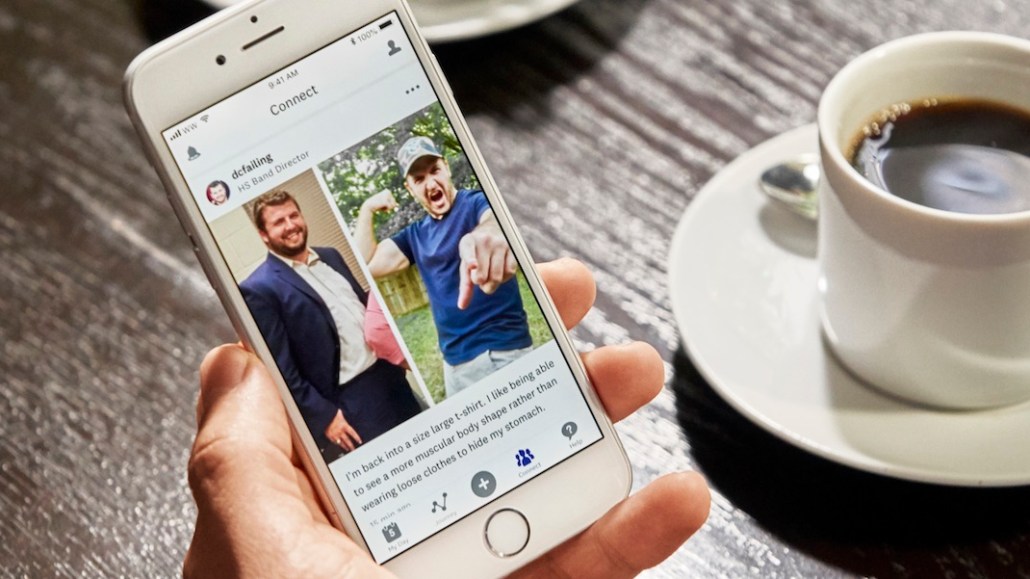Inside newly rebranded Weight Watchers’ mobile app strategy

Weight Watchers, which rebranded as WW this week, is building out its mobile app to become a personalized wellness platform that stands on its own, as opposed to an add-on to meetings that take place in person.
Starting next week, WW, a nod to the company’s new tagline “wellness that works,” will begin phasing updates to create a curated experience based on what it knows about the customers. WW aims to make its app a one-stop shop for everything fitness-related, with capabilities to track fitness activity, goals, eating habits and opportunities to connect with other customers through “Connect Groups” that resemble Instagram. The emphasis on data-driven mobile experiences is a response to the growth of mobile fitness platforms in recent years like Noom, Fitbit, LoseIt! and MyFitnessPal that help customers manage their weight through their phones.
“What we want to do is deliver an experience that meets our customers’ needs, and I think to do that well, we have to understand them better, and that centers around the data they provide,” said WW chief technology officer Michael Lysaght. “It’s all about using the data to help them on their journey in a way that will help them be more successful.”
For much of the 55-year-old brand’s history, it’s been known to focus on weight loss based on advice delivered through meetings held at a network of physical locations; the company currently has locations in 13 countries. The insights and advice delivered through the app will complement feedback customers receive from in-person events, but Lysaght said the app will also cater to a digital-only customer who chooses not to attend meetings or doesn’t have the time.
“The last few years have been focused on evolving into a modern, agile, technology-focused experience organization — we really needed to understand our members’ needs and how to meet those expectations,” he said.
Core to the app’s functions is a change to the way fitness points — what WW calls “FitPoints” — are calculated. They’ll be personalized based on the customer’s height, weight, age and sex, and, according to the company, the app will be able to recognize that 100 calories earned from one activity is different from the same amount of calories burned through another type of exercise. A new algorithm will also nudge customers to include high-intensity workouts and strength training into their fitness programs. Based on customers’ activity and preferences, they’ll get rewards (products, services and experiences, but Lysaght wouldn’t elaborate on specifics). WW is also upgrading its Instagram-type sharing capability called the “Connect Community” with interest-focused groups, including those dedicated to food, life stages and hobbies.
“Unlike other loyalty programs, ours will not be about dollars spent,” said CEO Mindy Grossman in an earnings call in August. “We will be rewarding members for positive behavior and actions that we know will lead to healthy habits, recognizing success with WW curated products and experiences.”
Over the past year, WW has shifted to a holistic health focus for its 4.5 million subscribers. The company is moving beyond subscriptions, which reportedly make up 80 percent of its revenue. It plans to roll out a meal kit service later this year, working with a third-party food logistics provider, and it’s partnering with digital health platform Headspace to offer its members customized content related to meditation and mindfulness.
The app updates create a runway for sales growth, and despite a potential drag on profitability from the reward program, it’s expected to help customer retention, JPMorgan analyst Christina Braithwaite wrote in a research note. WW’s advantage over rivals is the comprehensiveness of its offerings, while many other companies operating in the digital wellness field are focusing on a smaller number of capabilities, said Jonathan Smalley, CEO of data analytics company Yaguara.
“They’re really going for a platform play, owning every part of wellness — once they start to own that data with Smart Points, they’ll be able to see how different activities add up to a healthy lifestyle; [based on customer data] they’ll be able to build out applications for specific functions.” The challenge for WW will be to deliver on the heightened expectations of customers, he added.
Building out wellness as a platform was the inspiration for the company’s rebrand — emblematic of an industrywide shift away from weight loss and calorie counting to a broader health message.
“It’s really about understanding where consumers have the biggest pain points and trying to ease those through innovation and new business models,” said chief brand officer Gail Tifford.
More in Marketing

Best Buy, Lowe’s chief marketing officers explain why they launched new influencer programs
CMOs launched these new programs in response to the growing importance of influencers in recommending products.

Agencies create specialist units to help marketers’ solve for AI search gatekeepers
Wpromote, Kepler and Jellyfish practices aim to illuminate impact of black box LLMs’ understanding of brands search and social efforts.

What AI startup Cluely gets — and ad tech forgets — about attention
Cluely launched a narrative before it launched a tool. And somehow, it’s working.








